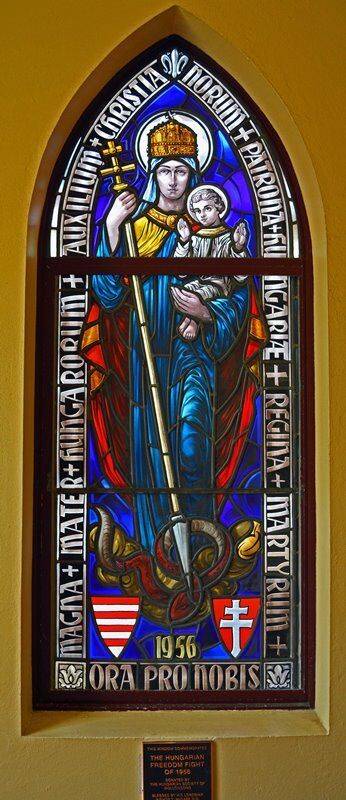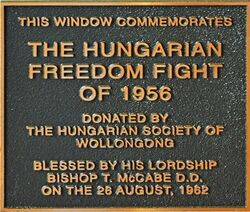
Home » Themes » Government » Oppression
Hungarian Freedom Fight of 1956Print Page 
The stained glass window commemorates the Hungarian Freedom Fight of 1956.
The Hungarian Revolution of 1956 or the Hungarian Uprising, was a nationwide revolution against the Hungarian People's Republic and its Soviet-imposed policies, lasting from 23 October until 10 November 1956. Leaderless at the beginning, it was the first major threat to Soviet control since the Red Army drove Nazi Germany from its territory at the end of World War Two in Europe.
The revolt began as a student protest, which attracted thousands as they marched through central Budapest to the Hungarian Parliament Building, calling out on the streets using a van with loudspeakers. A student delegation, entering the radio building to try to broadcast the students' demands, was detained. When the delegation's release was demanded by the protesters outside, the protesters were fired upon from within the building by the State Security Police, known as the ÁVH (acronym for Államvédelmi Hatóság, lit. 'State Protection Authority'). Multiple students died and one was wrapped in a flag and held above the crowd. This was the start of the next phase of the revolution. As the news spread, disorder and violence erupted throughout the capital.
The revolt spread quickly and the government collapsed. Thousands organised themselves into militias, battling the ÁVH and Soviet troops. During the revolt, there were violent incidents; some local leaders and ÁVH members were lynched or captured, while former political prisoners were released and armed. Radical impromptu workers' councils wrested municipal control from the ruling Hungarian Working People's Party (Magyar Dolgozók Pártja) and demanded political change. The new government of Imre Nagy formally disbanded the ÁVH, declared its intention to withdraw from the Warsaw Pact and pledged to re-establish free elections. By the end of October, fighting had almost stopped, and the days of normality began to return. Some workers continued fighting in opposition to both the Stalinist regime and the appearances of bourgeois parties in its wake.
Initially appearing open to negotiating a withdrawal of Soviet forces, the Politburo changed its mind and moved to crush the revolution. On 4 November, a large Soviet force invaded Budapest and other regions of the country. The Hungarian resistance continued until 10 November. More than 2,500 Hungarians and 700 Soviet troops were killed in the conflict, and 200,000 Hungarians fled as refugees. In Austria, large refugee camps were constructed from which emigration to other countries was arranged for the many refugees who escaped across the border prior to the military closure.
Mass arrests and denunciations continued for months thereafter. By January 1957, the new Soviet-installed government had suppressed all public opposition. These Soviet actions, while strengthening control over the Eastern Bloc, alienated many Western Marxists, leading to splits and/or considerable losses of membership for communist parties in capitalist states.
Location
| Address: | 36 Harbour Street, St Francis Xavier Cathedral, Wollongong, 2500 |
|---|---|
| State: | NSW |
| Area: | Foreign |
| GPS Coordinates: | Lat: -34.425556 Long: 150.901944 Note: GPS Coordinates are approximate. |
Details
| Monument Type: | Window |
|---|---|
| Monument Theme: | Government |
| Sub-Theme: | Oppression |
| Actual Event Start Date: | 23-October-1956 |
| Actual Event End Date: | 10-November-1956 |
Dedication
| Actual Monument Dedication Date: | Thursday 26th August, 1982 |
|---|
Magna Mater Hungarorum Auxilium Christia Norum Patrona
Hungarie Regina Martyru Ora Pro Nobus 1956
Plaque :
This window commemorates the Hungarian Freedom Fight of 1956
Donated by the Hungarian Society of Wollongong
Blessed by His Lordship Bishop T. McCabe D. D. on the 26 August, 1962






